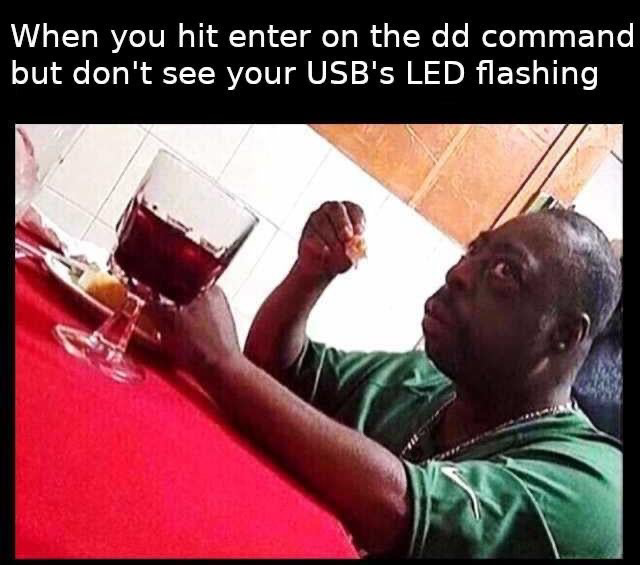this post was submitted on 05 Dec 2023
968 points (98.7% liked)
linuxmemes
21807 readers
736 users here now
Hint: :q!
Sister communities:
Community rules (click to expand)
1. Follow the site-wide rules
- Instance-wide TOS: https://legal.lemmy.world/tos/
- Lemmy code of conduct: https://join-lemmy.org/docs/code_of_conduct.html
2. Be civil
- Understand the difference between a joke and an insult.
- Do not harrass or attack members of the community for any reason.
- Leave remarks of "peasantry" to the PCMR community. If you dislike an OS/service/application, attack the thing you dislike, not the individuals who use it. Some people may not have a choice.
- Bigotry will not be tolerated.
- These rules are somewhat loosened when the subject is a public figure. Still, do not attack their person or incite harrassment.
3. Post Linux-related content
- Including Unix and BSD.
- Non-Linux content is acceptable as long as it makes a reference to Linux. For example, the poorly made mockery of
sudoin Windows. - No porn. Even if you watch it on a Linux machine.
4. No recent reposts
- Everybody uses Arch btw, can't quit Vim, <loves/tolerates/hates> systemd, and wants to interject for a moment. You can stop now.
Please report posts and comments that break these rules!
Important: never execute code or follow advice that you don't understand or can't verify, especially here. The word of the day is credibility. This is a meme community -- even the most helpful comments might just be shitposts that can damage your system. Be aware, be smart, don't fork-bomb your computer.
founded 2 years ago
MODERATORS
you are viewing a single comment's thread
view the rest of the comments
view the rest of the comments

Another advantage of having a NVMe SSD, hard to confuse /dev/nvme0n1p2 with /dev/sda1
It's even easier to prevent confusion if you use /dev/disk/by-id/ id's, it only took a few times of overwriting the wrong disk to figure that out.
I think that does the opposite for me lol
How can I figure out which direct device is associated with a specific id?
Not sure if it is equal on all distros but on every one I have used it's a readable string of muliple components. One of them is "usb" for a usb mass storage, so if it is the only one you have connected to your computer it is very obvious. For like sata disks it has the manufacturer and serial on it so you can match what drive it is you want to write to. Also, the name is pretty unique (on your sysytem at least, globally I don't know), so even if you swap hardware around, you cannot write to the wrong storage if you got the right name. Like "sdb" can be reassigned, but the id is an id.
They're symlinks, so you can just
ls -l /dev/disk/by-id, and you can see what is what.ˋblkidˋ or take a look around /dev, devices are symlinked to their various attributes.
When I accidentally decimated my external hard drive, it had NTFS cause there were a few windows machines I would plug it in. Then I reformatted the disk but then I thought to myself, should I have another partition for my Linux machine because that drive gets corrupted and then I need to plug to a Windows machine to repair it once in a while. Then I created an ext4 partition on the disk. Then a few days after I shrinked the NTFS partition and extended the ext4 to the whole disk. Now that disk only has one partition called sda2. Which is kinda weird but makes it easier to distinguish from others disks on the system.
I just make use of my paranoia, so I triple and quadruple check. Then get a coffee and quadruple check again. Never messed up once
Even if it's similar names I'd normally plug in USB, do
dmesg, then issue a command with latest device name.